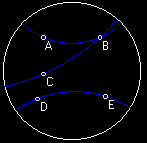
Parallel Lines

DEFINITION:
Parallel lines are infinite lines in the same plane that do not intersect.
In the figure above, Hyperbolic Line BA and Hyperbolic Line
BC are both infinite lines in the same plane. They intersect
at point B and , therefore, they are NOT parallel Hyperbolic lines.
Hyperbolic line DE and Hyperbolic Line BA are also both infinite
lines in the same plane, and since they do not intersect, DE is
parallel to BA. Likewise, Hyperbolic Line DE is also
parallel to Hyperbolic Line BC. Now this is an odd thing since
we know that in Euclidean Geometry:
If two lines are parallel to a third line, then the two lines are parallel
to each other.
This is a theorem in Euclidean Geometry, yet in Hyperbolic Geometry it
is proved false by the above counter example (Both BA and BC are parallel
to DE, yet BA is not parallel to BC). However, you may not be convinced
that BA and DE are parallel. In order to help convince you, I would
like to first focus on the fact that each of the lines shown above is Infinite.
The lines do not look infinite. We generally think of infinite lines
as lines that go on forever, but actually, infinite lines are lines that
do not have an end. "Going on forever", and "not having an end" are
not the same thing. Remember that in this model of Hyperbolic Geometry,
objects get smaller as they get closer and closer to the Boundary Circle,
and that the distance from any point within the Boundary Circle to the
edge of the Boundary Circle is Infinite. Even if a Hyperbolic line
Segment is 100 million, miles long, then it still would not reach
the Boundary Circle, and either end of the line segment can be extended.
A Hyperbolic Line is not the same thing as a Euclidean Line (for example,
Hyperbolic Lines curve). They do, however, share many analogous properties.
The following is a list of some of these properties:
-
In Euclidean Geometry, there is one and only one shortest path between
any two points. We call this "shortest path" the "straight" path,
and this path lies along the line segment joining the two points.
Exactly the same statement is true in Hyperbolic Geometry with Hyperbolic
Points and Hyperbolic lines.
-
In Euclidean Geometry, two points determine a unique line. In-other-words,
given any two points, there exists a line that passes through those two
points. Additionally, there does not exist any other line that will
pass through both of those two points. Exactly the same statement
is true in Hyperbolic Geometry.
-
In Euclidean Geometry, Light, in a vacuum, travels along a Euclidean Line.
Likewise, in Hyperbolic Geometry, Light, in a vacuum, travels along a Hyperbolic
Line.
Is spite of these similarities Hyperbolic lines have many different properties
from Euclidean Lines. For example, the following Euclidean Geometry
theorems are FALSE in Hyperbolic Geometry:
-
In Euclidean Geometry, if two lines are parallel to a third line, then
the two lines are parallel to each other.
-
In Euclidean Geometry, if two lines are parallel then, the two lines are
equi-distant.
-
In Euclidean Geometry, lines that do not have an end (infinite lines),
also do not have a boundary (a point that they are headed toward, yet never
reach).
 NonEuclid Home
NonEuclid Home
 Next Topic - Postulates and Proofs
Next Topic - Postulates and Proofs
Copyright©: Joel Castellanos, 1994-1997

